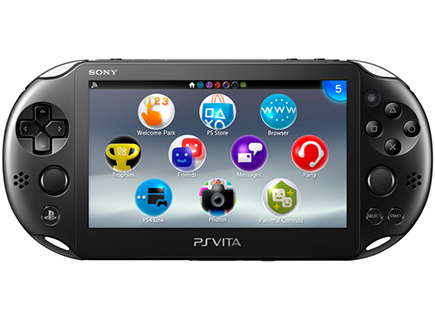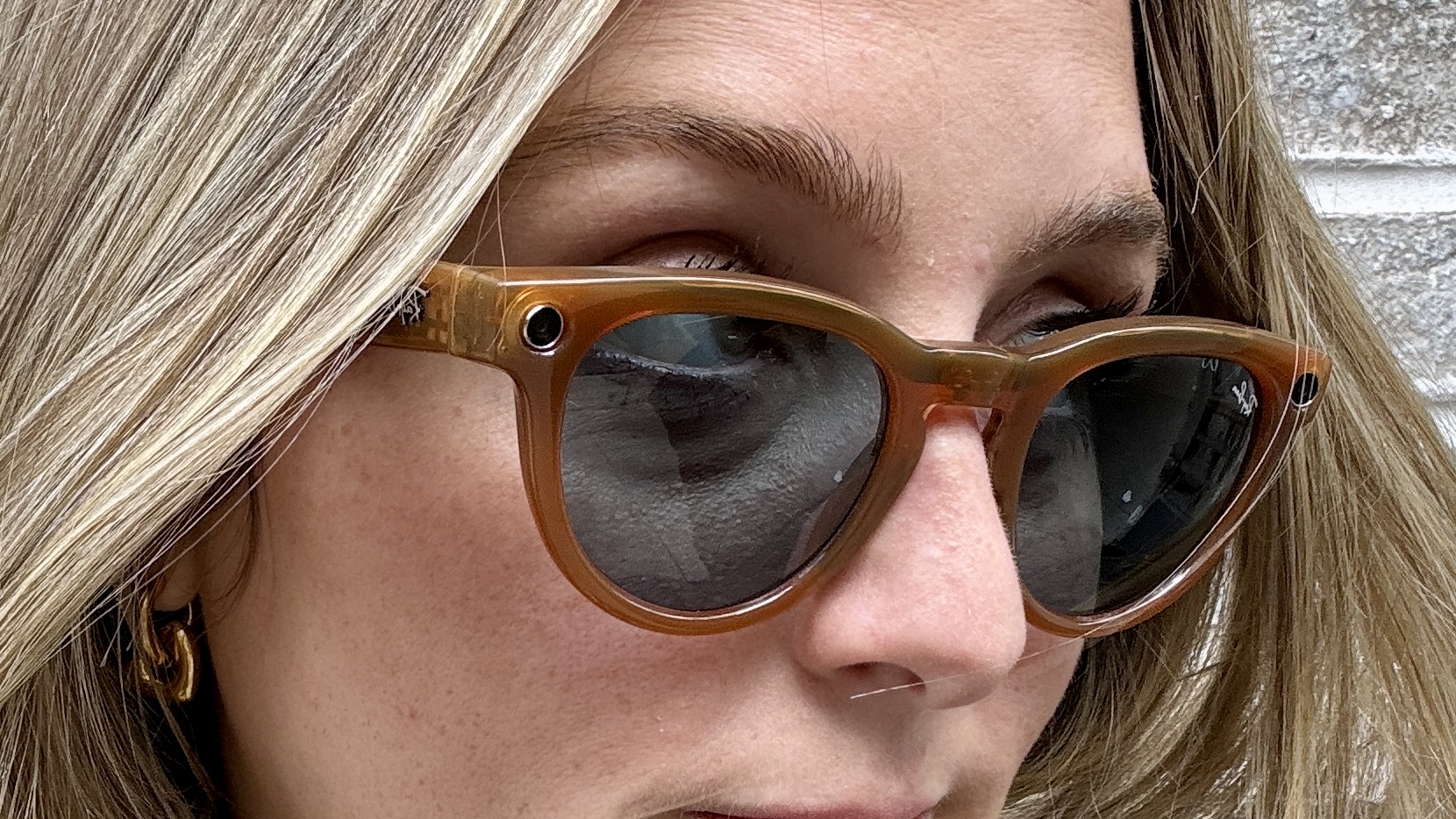Tom's Guide Verdict
The PlayStation Vita Slim sports a sleeker design, longer battery life and more games than the original, but the controls could be better.
Pros
- +
Thinner, lighter design
- +
Solid LCD display
- +
Robust games library
- +
Micro USB charging capability
Cons
- -
Analog sticks can be uncomfortable with certain games
- -
Expensive proprietary PlayStation memory cards
Why you can trust Tom's Guide
Since 1989, Nintendo has been the gold standard when it comes to handhelds. There have been many challengers to the throne -- the Sega Game Gear, Neo Geo Pocket Color and Nokia N-Gage -- all ultimately defeated by Nintendo's seemingly untouchable popularity.
But Sony isn't giving up. As the latest contestant for the handheld superiority, the $199 PS Vita Slim is a svelter take on the original Vita. In addition to the sleeker look, the Slim offers an expanded game library and remote play goodness for your PS4. But does Sony's sequel have what it takes to finally win me (and you) over?
Design
It's not called the Slim for nothing. The new Vita weighs 8.2 ounces and measures 0.4 x 4.1 x 5.3 inches, which is notably smaller and lighter than the original (9.9 ounces, 7.2 x 3.3 x 0.7 inches).
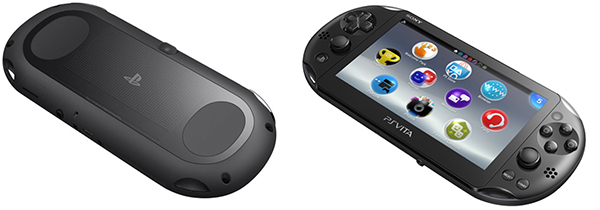
Sony also gave the Slim a number of cosmetic tweaks that make the device look more mature than the original. Instead of the matte gray and chrome accents on the first Vita, the Slim's clear plastic D-pad and face buttons are glossy black, as are the power and volume buttons. Sony kept the pair of clear plastic bumpers, but they're definitely smaller. Other minor changes include making the PlayStation, Select and Start buttons circular instead of oval.

The Slim's 3.5 x 2.2-inch touch panel is surrounded by black matte plastic that wraps elegantly around the sides. It's slightly smaller than the original Vita's touchpad, which measured 4.4 x 1.8 inches. However, the black matte handgrips on the Slim are larger, making for a more comfortable grip.
MORE: Tom's Guide Gaming Glossary
Sony managed to cram a few more ports along the Slim's bottom, including microUSB, a headphone jack and proprietary slot for Vita memory cards.
Get instant access to breaking news, the hottest reviews, great deals and helpful tips.
Display
Any time a company presents a lighter, slimmer version of a gadget, you can expect a compromise or two. In the case of the Vita Slim, that sacrifice manifests in the display. The handheld still boasts a 5-inch touch panel with a 960 x 544 resolution. Sony, however, has replaced the original's OLED screen with LCD technology.
In a side-by-side comparison, the original Vita delivered brighter colors than the Slim, particularly when it came to reds and blues. When we checked out Borderlands 2's cel-shaded vistas, the colors definitely popped more on the OLED panel. However, details on both systems were about even, as evidenced by the fuzziness of the falling snow and exploding gas tanks.
MORE: Xbox One and Playstation 4: Which Console Wins?
The Slim offers generous viewing angles, preventing colors from washing out. The panel is also bright enough to allow playing in direct sunlight, but at 205 lux, is somewhat dimmer than its predecessor, which hit 222 lux.
Controllers and Touchpad
Outside of a few decorative changes, the Vita's dual analog sticks haven't changed much, which is both good and bad. When I played Dragon's Crown, the sticks delivered smooth, relatively precise movement. However, it's one thing to play a hack-and-slash game, and quite another to play a first-person shooter.
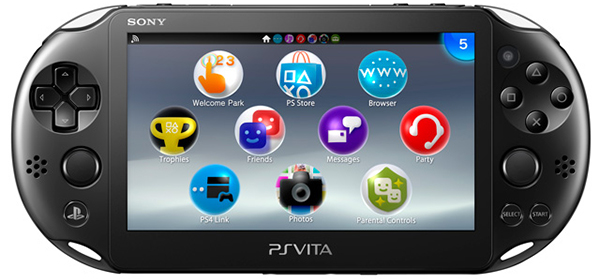
When I started braving the wilds of Pandora in Borderlands 2, the small sticks became somewhat of a hindrance. Although I was dispatching bullymongs and psychos left and right, I had some difficulty lining up shots. I found myself constantly fighting with the sticks to line up headshots.
MORE: Best Gaming Keyboards 2014
We had an even tougher time with the melee button mapped to the rear touch panel. Despite the designated handgrips, I found my fingers continuously landing on the touchpad, causing our Psycho to flail his club wildly. Combined with the imprecise targeting, I wouldn't recommend playing Borderlands or any other multiplayer shooter on the Vita. Unless you're fond of catching facials.
Software and Interface
Not much has changed concerning the software and interface on the Vita Slim, which remains a nice blend of current smartphone touch-screen conventions blended with the PlayStation 3 layout.
Games, apps and utilities are still represented as colorful circular buttons that wiggle when you swipe over them. The icons look slightly cleaner on the Slim than the original, but aside from that, everything else looks and functions the same.
The peel-away panel with the large digital clock still graces the lock screen, while the home-screen features 10 icons including PS Store, Browser and Welcome Park, the Vita tutorial. When you install a new game or app, a new icon is created.

Launching an app takes gamers to LiveArea, which opens to the right of the home screen. You can open six LiveArea screens at a time, which makes the navigation fairly simple. A quick tap of the PS button shows the panels in a cascading view, while holding the button for 2 seconds launches a Settings display.
The small start panel in the center of each LiveArea screen launches the program. A small life preserver icon at the top of every screen still opens the online PS Vita manual in case you need help. Similar to the icons, each LiveArea screen sports its own look, creating visually appealing presentations.
Game Selection and Quality
What a difference two years make. When I reviewed the original Vita, there were only 25 titles available, such as Uncharted: Golden Abyssand Ultimate Marvel vs. Capcom. The PS Vita library now hosts more than 1,000 games, comprised of a mix of exclusive Vita titles and games ported from the PlayStation One and PlayStation Portable.
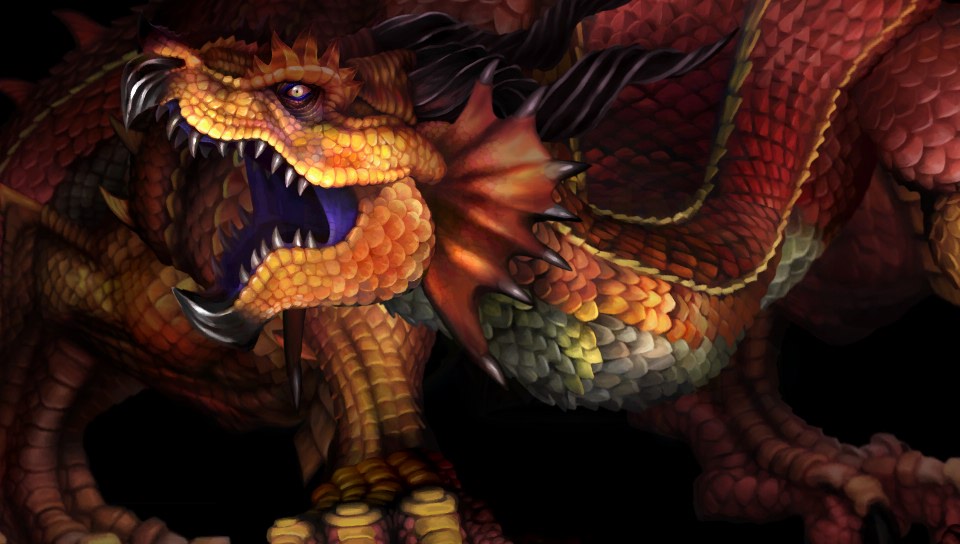
Although Dragon's Crown is my current addiction, you'll also want to check out Street Fighter X Tekken PS Vita, Child of Light or Persona 4 Golden. Original Vita games, such as Uncharted, can also be played on the Slim via digital download or a physical copy.
While the Vita library appears to be growing at a healthy pace, you won't find many AAA titles. Assassin's Creed: Liberation, Persona 4 and Lego Marvel Super Heroes are some of the exceptions. Titles such as Call of Duty, Battlefield and Madden are noticeably absent. However, the Vita is quickly becoming the go-to gadget for indie games such as Doki Doki Universe, Worms Revolution Extreme and MouseCraft, which isn't a bad thing.
Game prices range from $1.99 to $39.99. The Vita also has a growing collection of free-to-play titles, including Zen Pinball 2 PS Vita and Jetpack Joyride.
Remote Play
Like the original, the Vita Slim features Remote Play, which lets you play PS3 or PS4 games on your Vita -- provided everything's connected to the same network. I tested the feature out with great success when my boyfriend wanted to watch the Mets game and I wanted to continue my marathon run of Assassin's Creed IV: Black Flag.

Setup takes about 5 minutes on either console once all the settings have been adjusted on the handheld and console. From there, it's just a simple matter of launching the PS3 Remote Play App (PlayStation 3) or the PS4 Link app (PlayStation 4) and waiting 3-4 seconds for the systems to find each other.
Once I launched the app and the Vita Slim and my PS4 were synced, I continued looting ships and slaying Templars. Sure, it's a smaller display, but at least I didn't have to stop gaming. (The Mets lost, by the way.)
While Remote Play comes in handy when it's time to share the TV, be aware that not all games are compatible with Remote Play. And even if they are, some only work on PS3.
Second Screen
Gamers who own both a PS4 and a Vita Slim can use the handheld's Second Screen ability. The feature essentially uses the Vita's display as a companion app, providing gamers with additional content. If it's not being used for gaming, Second Screen doubles as a remote for your PS4, allowing you to navigate between apps using the touch screen.
In terms of gaming, there aren't many options. I used Second Screen with Playroom, the cute robot-themed demo. In this scenario, the Vita lets players create toys for the little robots to play with.

I'd love to see Second Screen support such titles as Assassin's Creed IV: Black Flag and Infamous: Second Son. However, it's difficult to persuade developers to create this functionality for the Vita when it's easier to make apps for Android and iOS that will ultimately reach more people. Case in point: Ubisoft created a companion app for Assassin's Creed IV that transforms your smartphone into an interactive world map, allowing players to send their fleet on missions, set waypoints and view treasure maps.
Apps
Just like the interface, Sony left the Vita's pre-installed apps and programs untouched. In addition to the Welcome Park, PS Store and the Browser, the social-minded Friends, Party and Near apps make a return. Friends lets you keep tabs on which of your friends are online in the PlayStation Universe. Party lets you start a group voice chat with up to eight people no matter what game you're playing.
Near is Sony's take on Nintendo's StreetPass, combining geo-location, social networking and gaming. The software allows gamers to check into locations and see what other PS Vita gamers are playing at the moment. The Friends feature taps into the Friends app, while the Out & About feature helped me find a gamer walking around Union Square Park who was also playing Borderlands 2.
Sony's Music app lets you stream tunes from a PlayStation 3 or PC or access the music downloaded to the Vita Slim's memory card using the Content Manager app. Streaming music from my PC took some work, including installing the Content Manager Assistant app on the PC and putting both devices on the same network. It took about 15 seconds to sync up with my Lenovo Y50, but overall it was a relatively painless process. I recommend using this method instead of taking up precious gaming space on Sony's expensive, proprietary memory card.
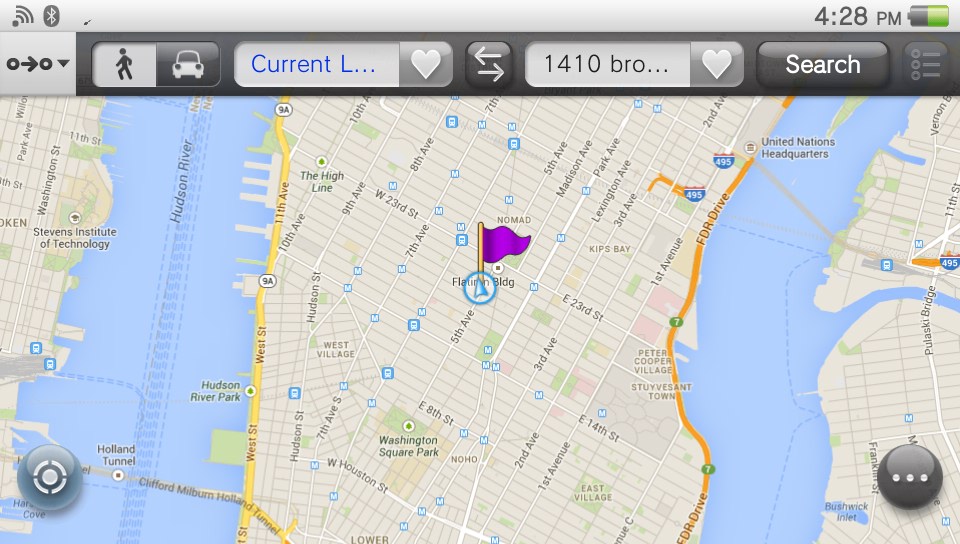
Just in case you get lost tracking down your fellow PlayStation Petsplayers, Google Maps has been added to get back on track. Just like the original Vita, this version offers Map and Satellite views along with Directions.
Other apps include Settings, Parental Controls, Email and PS3 Remote Play. A recent update added the PS4 Link app, which enables gamers to set up remote play on their PlayStation 4s or use the Vita Slim as a second screen.
In addition to games, the PlayStation store also features such entertainment apps as Netflix, Hulu, Redbox Instant by Verizon, Crackle, Skype and YouTube.
Performance
The PlayStation Vita Slim has the same quad-core ARM Cortex-A9 MP Core processor as its predecessor, but double the RAM at 1GB. I found myself zipping through apps and screens. Most apps took less than a second to launch, while games took 2 seconds on average.
The Slim's SGX543MP4+ GPUdid a marvelous job rendering Dragon's Crown.It felt like I was playing in a masterfully painted storybook. My scantily clad Amazon and her band of heroes smoothly hacked and slashed their way through legions of orcs, skeletons and other things that go bump in the night.
MORE: 12 Most Maddeningly Difficult Games of All Time
If only things were that seamless on Borderlands 2.As I made my way through the harsh, unforgiving world of Pandora, there were a few instances of stuttering that took away from the overall experience. It's bad enough having to incorporate the rear touch panel for such a dedicated shooter. But watching the game struggle to render can be maddening. Textures on the cel-shaded title were muddier than playing the game on my PC and PlayStation 3.
Memory Cards
In addition to shelling out money for games and apps, gamers should also put aside a few dollars for a memory card. In some sort of nefarious plot, Sony chose not to add any onboard memory to the handheld, so shoppers are forced to purchase one of Vita's proprietary memory cards.
Those who purchase the Borderlands 2bundle will get an 8GB memory card with the game. Otherwise, gamers can expect to pay from $14.99 for a 4GB memory card to $79.99 for a 32GB card. Amazon also sells 64GB cards for a whopping $94.99. The cards are pricey, but definitely necessary. The Vita version of Dragon's Crownis a manageable 980MB but Borderlands 2 will take up decent chunk of space at 4.9GB.
Camera and Camcorder
The Vita Slim sports the same 1.3 megapixel front- and rear-facing cameras as the original, and both capture images and video in 640 x 480. In addition to the fairly low resolution, many of my test shots lacked vibrancy. The deep rich reds, bold purples and radiant yellows in bouquets of flowers were reduced to pale, ashen shadows of themselves.

When I snapped a few selfies, I noticed that both my skin tone and my turquoise shirt looked washed out. Details, such as the flower petals on my shirt and my curled locks were very grainy.
The lackluster color and detail carried over to the video I captured of passing New York City traffic. Normally golden taxis looked dusty.
Battery Life
If switching from OLED to LCD has no other advantage, it helps extend the battery life. When I played Borderlands 2on the original Vita at full brightness, I got a little over 3 hours of gameplay. On the Vita Slim, that time jumped to 4 hours and 27 minutes.
Bottom Line
Sony hasn't given up on the PlayStation Vita, and with good reason. For $199, this is the most powerful gaming handheld on the market. Smaller dimensions, longer battery life and a steadily growing catalog of games makes a compelling case to add the Vita to your tech arsenal. Gamers who already own a PS3 or PS4 get the added bonus of Remote Play, Second Screen and a host of other features. However, the dearth of AAA titles is a problem that Sony will need to solve if it wants its handheld to be perceived as more than a console accessory.

Sherri L. Smith has been cranking out product reviews for Laptopmag.com since 2011. In that time, she's reviewed more than her share of laptops, tablets, smartphones and everything in between. The resident gamer and audio junkie, Sherri was previously a managing editor for Black Web 2.0 and contributed to BET.Com and Popgadget.
-
MetalUpYourAss81 Really, complaining about that damn analog sticks?? I've owned a PS Vita since my pre-ordered launch edition bundle, and have absolutely no problems what so ever with the analog sticks, I completely 100% disagree with that statement and believe the Vita offers the best precise controls for mobile console quality gaming to date. If it weren't for the dual analog sticks and rear touch Remote-Play wouldn't even be possible, it was code named the NGP (Next Gen Portable) for a reason. I would recommend looking into buying a pair of PDP Trigger Grips for the Vita if you seriously are having problems with the analogs, what a stupid thing to nitpick on, its idiot reporters like you that give the Vita a bad name. Also are you aware of the fact that you can re-map the controls for Borderlands 2 to your own personal preferance? Ya check the options menu buddy, by the sounds of it you didn't even take the time to check or even care. I would recommend mapping sprint to the Circle button (in the same manner as Killzone Mercenary) and mapping melee attack to the right hand corner of the touch screen (similar to Call of Duty Declassified, kinda like a hybrid between both games controls) and mapping grenade throw to the triangle button, and crouching/swapping weapons to the rear touch pad. There. I just fixed the god damn game for you. I currently own every FPS the Vita has to offer as well as many many other games and I also disagree with your statement about not recommending Borderlands 2 or any other multiplayer games on the Vita, have you even played Killzone Mercenary??? What Sony has accomplished is Console quality multiplayer match making on the go that is far more superior over any phone game which some people try to compare with as it has more of a premium feel on Vita, and is optimized to run and work well on the system. I think one of the things many things people misunderstood about Call of Duty Declassified is the fact that the game was built with a primary focus on the multiplayer aspect of the game, it has everything COD multiplayer on consoles has to offer, everything from customizable weapons and classes as well as perks and killstreak rewards to clantags, full prestige levels and ranks, challenges, game modes maps from the original Black ops etc the list goes on, I recommend people take a look at videos on youtube of Declassifieds multiplayer before taking a reviewers word for what their personal opinion of the game is. Sometimes you have to judge for yourself, I for one happen to love declassified and its my favorite call of duty for multiplayer action since the original Black Ops. I personally prefer Black Ops' class of of weapons over any other Call of Duty as they are my favorite weapons to use which is why I find Declassified so addicting, I actually prefer Declassifieds multiplayer over Call of Duty Ghosts on my PS4 as I find that Call of Duty (specifically infinity wards') is becoming way to repetitive, atleast Declassified has a different engine and more of an apeal to me with PS3 near graphics and console quality multiplayer all in the palm of your hands, then the same copy and paste console COD we recieve on the yearly basis. If your gonna nitpick on something as ridiculous as the fucking analog sticks then you have no place reviewing the godamn Vita. Also did you expect Borderlands 2 on the Vita to look better then the PS3 and PC version? I was definitely not expecting it look better as this is a goddamn handheld were talking about, I got past the slight framerate hiccups and am enjoying the game for what it is having not played the game previously, its great experiencing it for the first time on the Vita and I am actually quite blown away that they are managing to fit all of these full console ports of games onto the handheld, something too many people don't seem to appreciate like myself. I actually prefer the Vita's full console PS3 ports of games over the actual PS3 versions as I think they are the more superior version of the game because I think its more impressive playing them on the Vita as the graphics are nearly as great as on PS3, that and also the fact that they are running on a handheld and are fully portable. The Vita deserves a 10 out of 10 (or in this case) a 5 out of 5 stars as its I think it is truly the best handheld ever made to date, and is only getting better and better with games like the full PS3 console ported Version of Minecraft coming next month, and great features like Remote-Play, the Vita has no where to go but up.Reply -
drd7of14 This article was so inaccurate on so many things. It doubled the RAM...Really? It has more games than the original???!? Huh?!? How about putting some effort into your research on a Slim unit that came out months ago. How about you try harder next time to be a "journalist" instead of cluttering up my search results on Google, and spouting nonsense and misinformation to those that are interested. It's a great product, sure, but the differences to the VITA SLIM from the original are mostly just minimal storage (1GB) change to the form factor (Saves them money I assume) which alters some controls, such as the rear-touch pad and start/select buttons, and OLED to LCD screen, which increases battery power by 1 hour of gameplay use, and again saves them on production costs. Those are the only changes to the unit. There is no 3G offering of this model either.Reply -
Icomment Thanks for the review Sherri. It’s always nice to hear another view of the Vita, as I’ve been considering a handheld purchase lately (PS Vita or 3DS XL).Reply
I’ve read similar complaints about accidental bumps of the rear touch pad and the small range of the thumbsticks making accuracy a problem in some games but then I there are … “Passionate” … rebuttals from Vita owners like MetalUp who don’t mind the thumbsicks and have found better uses for the rear touchpad by remapping the functions. I’ve also seen some games (ie. uncharted) use motion controls to fine tune aiming, though I’m not sure how wide spread that solution is.
I noticed some inconsistencies with other reviews I’ve read though. I believe the RAM is the same for both the original and the slim vita while you suggest it’s been doubled. You also mention that “Sony chose not to add any onboard memory” but that’s only true of the original. The Vita slim has 1Gb built in memory (still not much and can’t be used with a mem card installed).
Not sure if you check comments but could you comment on the connectivity of the Vita? For example, is the online stable in all the multiplayer games you’ve played (wrt lag, or disconnecting during match) and is the Vita online community robust enough that you don’t have trouble finding others for online matches. Also, how often do you see people on Near (or do you even use it)? Nintendo’s Streetpass seems very successful, well utilized and integrated into a number of games. Is Near similar or just a failed feature that no one really uses?
Thanks again!
-
solkeher I have the original Vita (with the OLED screen) and was hoping that the slim version could improve on the analog sticks, but I'm not surprised they did not. I usually use my vita when I travel and that's when I really enjoy the device. Otherwise I barely touch the thing...Reply -
MetalUpYourAss81 Oh I guess I didn't notice that its a woman that did this review, no wonder she had problems with the analogs etc.. Probably just a casual gamer like most ladies are haha. Disregard this review to anyone who is really interested in a Vita, and take it from a real hardcore player who actually uses the device on a daily basis and actually cares about the handheld like myself see my above comment^^. For anyone else who actually has problems with the analogs, that is by far the best thing about the fucking PlayStation Vita is the fact that it actually has real dual analogs and actually alone justifies purchasing one. For gamers like myself who came from owning and enjoying the original PSP, the Vita's analogs are a huge step up and add way more to the experience of gaming on the handheld, it really is the successor to the PSP. It even makes PSP games downloaded from the PSN way way better to play on the Vita as you can map the second analog stick to make games like Medal of Honor Heroes, Rainbow Six, Resistance Retribution, Grand Theft Auto etc.. practically any game dual analog which ads way more to the gameplay of allot of games. Another thing not mentioned by allot of reviewers. Again to anyone who complains about the Vita's analog sticks look into purchasing a pair of PDP Trigger Grips for the handheld, as they add way more extra grip and better trigger functionality and basically turn the Vita into a controller and a console right in the palm of your hands, I strongly recommend them to anyone who wants to add to the Vita's gameplay and grip of the handheld, and anyone who uses Remote-Play allot, definitely the best attachment you can get for the Vita. If your curious as to how they look take it upon yourself to do a quick google search, they look fantastic and feel great, and anyone who also lives in Canada I would recommend the Biogenic Trigger Grips which you can find at your local EB Games, as the PDP Trigger Grips are only available in the US unless you order them online like myself. Oh and one thing I forgot to mention is they recently patched Borderlands 2 on the Vita so you have the option to scale the size of the buttons on the rear touch pad making it less prone to accidentally touching the rear touch pad, another thing the reviewer obviously didn't take the time to check, by the sounds of it she just threw the game in for a few minutes to do a quick review, which is quite unfair to judge a game that you didn't take the time to play through or mess around with the settings LOL. I would also like to add to the above comment about the Vitas multiplayer connectivity, I find that the Vita actually has no lag what so ever when playing online games, games like Killzone Mercenary and Call of Duty have literally no lag and seem to run better then PS3 online games, Call of duty always has people playing it, it may take a couple of trys to get into a match but once you get in its a blast, like I said above the game has absolutely no lag what so ever, I hardly ever have trouble finding matches, and Killzone is always instant for finding matches and the connectivity is great and also runs perfectly with absolutely no lag, check out some videos on YouTube of multiplayer if your interested. If your a fan of shooters I would definitely recommend getting a Vita over a 3DS as I own both handhelds and hardly ever touch my 3DS as there are hardly any games that apeal to me, there are barely any shooters and not one single FPS on the 3DS, that's the reason why I play my Vita allot more as I am more of an FPS/shooter fan, not only that but as I own both a PS3 and PS4 I can check my friends list/Trophies and message friends from the Vita between all three platforms and can actually cross-party chat with my friends that are on PS4, if a friend is in a party on their PS4, I can join the party and chat with them directly from the Vita using its Party application and the Vitas built in mic or the PS4's bundled mic, that alone makes the Vita worth purchasing. Say I'm chilling on the couch playing my Vita and a friend messages me and wants to play on PS4, I can then enter Remote Play and get everything set up launch the game and join the party so all I have to do is go into my room pick up my DS4 and play, pretty fucking sweet if you ask me. I've played and beat Resident Evil Revelations on 3DS and I would say its about the only good shooter the 3DS has to offer. Other than that there are mainly just platformers and kiddie games on the system that don't appeal to me all that much and don't really keep me coming back to play over and over again like Killzone Mercenary and Call of Duty as these games offer great online ranking systems/leveling up that keep me hooked and have console quality multiplayer matchmaking anywhere I have access to WiFi. That and I also prefer playing full PS3 ported games on the Vita, something the 3DS just isnt capable of. The Vita is just 2 years old having launched in North America in 2012 and currently has 4 FPS's available, 6 if you count Minecraft which comes out next month and Duke Nukem 3D which is currently going through bug testing and is set to launch soon, much better then what the 3DS has to offer in terms of FPS's which is nothing. In my mind the Vita cripples the 3DS in terms of graphic fidelity and horsepower as well as features and online connectivity, it has a more mature feel and way more mature games, if you enjoy being treated like a child by the 3DS's OS then feel free to look into buying one haha.Reply -
Philip Heebsh It doesn't have more games than the original. The whole point of a slim version- like a top-loading NES or EVERY PlayStation system released, is that it plays all the same games as its non-slim predecessor. That's the point. That's why it's the Vita slim, not the Vita 2.Reply
This is a pretty damning issue to not understand when writing such a review.
